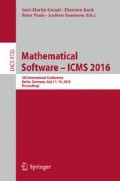Abstract
We apply SAT and #-SAT to problems of computational topology: knot detection and recognition. Quandle coloring can be viewed as associations of elements of algebraic structures, called quandles, to arcs of knot diagrams such that certain algebraic relations hold at each crossing. The existence of a coloring (called colorability) and the number of colorings of a knot by a quandle are knot invariants that can be used to distinguish knots. We realise coloring instances as SAT and #-SAT instances, and produce experimental data demonstrating that a SAT-based approach to colorability is a practically efficient method for knot detection and #-SAT can be utilised for knot recognition.
D. Stanovský—Partially supported by the GAČR grant 13-01832S.
Access this chapter
Tax calculation will be finalised at checkout
Purchases are for personal use only
References
Buck, D., Flapan, E. (eds.): Applications of Knot Theory. American Mathematical Society Short Course, San Diego, CA, USA, 4–5 January 2008. American Mathematical Society (AMS), Providence, RI (2009)
Burton, B.A., Özlen, M.: A fast branching algorithm for unknot recognizion with experimental polynomial-time behaviour (2012). http://arxiv.org/abs/1211.1079v3
Culler, M., Dunfield, N.M., Weeks, J.R.: SnapPy, a computer program for studying the topology of \(3\)-manifolds. http://snappy.computop.org
Clark, W.E., Elhamdadi, M., Saito, M., Yeatman, T.: Quandle colorings of knots and applications. J. Knot Theory Ramif. 23, 1450035 (2014)
Cha, J.C., Livingston, C.: Knotinfo: table of knot invariants. http://www.indiana.edu/~knotinfo. Accessed Jan 2015
Quandle colouring data (2015). http://cgi.csc.liv.ac.uk/~alexei/quandle_colourings
Dynnikov, I.A.: Recognition algorithms in knot theory. Uspekhi Mat. Nauk 58(6(354)), 45–92 (2003)
Fish, A., Lisitsa, A.: Detecting unknots via equational reasoning, I: exploration. In: Watt, S.M., Davenport, J.H., Sexton, A.P., Sojka, P., Urban, J. (eds.) CICM 2014. LNCS, vol. 8543, pp. 76–91. Springer, Heidelberg (2014)
Fish, A., Lisitsa, A., Stanovský, D.: A combinatorial approach to knot recognition. In: Horne, R. (ed.) EGC 2015. CCIS, vol. 514, pp. 64–78. Springer, Heidelberg (2015). doi:10.1007/978-3-319-25043-4_7
Faddeev, L., Niemi, A.J.: Stable knot-like structures in classical field theory. Nature 387, 58–61 (1997)
Flint, O., Rankin, S.: Gauss codes for the distinct minimal diagrams for the primealternating knots of 13 crossings. http://www-home.math.uwo.ca/~srankin/knots/knotprint.html. Accessed Jan 2016
Hass, J., Lagarias, J.C., Pippenger, N.: The computational complexity of knot and link problems. J. Assoc. Comput. Mach. 46, 185–211 (1999)
Jaeger, F., Vertigan, D.L., Welsh, D.J.A.: On the computational complexity of the Jones and Tutte polynomials. Math. Proc. Camb. Philos. Soc. 108, 35–53 (1990)
Kuperberg, G.: Knottedness is in NP, modulo GRH. Adv. Math. 256, 493–506 (2014)
Sumners, D.: Untangling DNA. Math. Intelligencer 12, 71–80 (1990)
Author information
Authors and Affiliations
Corresponding author
Editor information
Editors and Affiliations
Rights and permissions
Copyright information
© 2016 Springer International Publishing Switzerland
About this paper
Cite this paper
Fish, A., Lisitsa, A., Stanovský, D., Swartwood, S. (2016). Efficient Knot Discrimination via Quandle Coloring with SAT and #-SAT. In: Greuel, GM., Koch, T., Paule, P., Sommese, A. (eds) Mathematical Software – ICMS 2016. ICMS 2016. Lecture Notes in Computer Science(), vol 9725. Springer, Cham. https://doi.org/10.1007/978-3-319-42432-3_7
Download citation
DOI: https://doi.org/10.1007/978-3-319-42432-3_7
Published:
Publisher Name: Springer, Cham
Print ISBN: 978-3-319-42431-6
Online ISBN: 978-3-319-42432-3
eBook Packages: Computer ScienceComputer Science (R0)

